THIS week’s property review includes this wrap-up of interesting recent listings across the country, and a separate article of recently completed sales of note.
- Historic farming family bows out of Proserpine after 124 years
- Grassed properties in high demand in Queensland
- Aviation history behind Mudgee grazing operation
- Drought bites three NSW Upper Hunter listings
Historic farming family bows out of Proserpine after 124 years
One of the largest holdings in the Proserpine region, in the heart of Central Queensland’s Whitsundays coast, will be offered to the market for the first time in 124 years.
The 100-year-old Faust family farm is a substantial beef and sugar cane production asset spanning 3134ha, with a sizeable 3119ML water rights portfolio.
The Faust family has been part of the Proserpine community since 1895 when it established the local store. In 1910 the Fausts became involved in cattle production and then the family expanded into sugar cane growing.
Peter Faust is widely regarded as the man who paved the way for the development of two critical infrastructure projects that ultimately underpinned the growth and prosperity of the Whitsunday region.
In the early 90s, under his leadership, the council secured government support to establish Lake Proserpine, which now bears the family patriarch’s name, ‘The Peter Faust Dam.’
It is also rumoured that Mr Faust convinced the late Sir Reginald Ansett, the then owner of Hayman Island, to invest in the development of the Proserpine airport, now known as the gateway to the Whitsundays.
The Faust family aggregation is being offered to the market by Elders Real Estate general manager Tom Russo, together with local rural property sales specialist Robert Murolo, via an expressions of interest campaign closing late April.
Mr Murolo said it is unprecedented for a farming enterprise of this size and quality to be offered to the market in the Proserpine district.
“Given the scale of the asset, we are anticipating it will attract investors from the local market and further abroad including large private operators, corporate farmers and investment funds.”
The operation boasts high quality pastures that can carry 500 breeders plus followers.
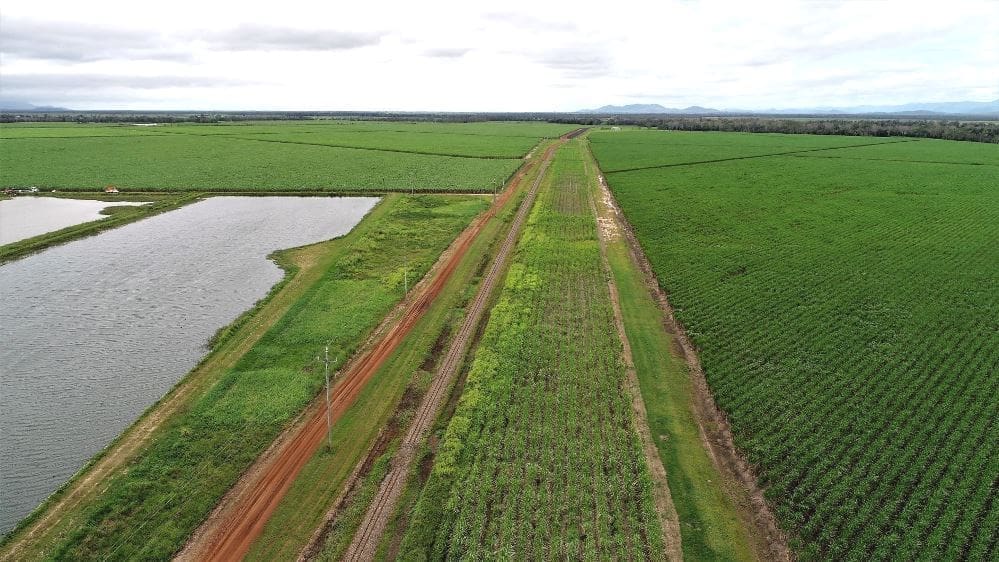
The 100-year-old Faust family farm near Proserpine is a substantial beef and cane farming asset spanning 3134ha, with a sizeable 3119ML water rights portfolio.
Grassed properties in demand in Queensland
Following our earlier reports on ‘grass fever’ breaking out in northwest Queensland since February rain , agents have been overrun with inquiries for Caledonia, a 30,100ha grassed grazing property 110km from Aramac.
The property is being sold via an expressions of interest campaign by Landmark Harcourts, Slaney and Co and Simstock Rural.
Charters Towers based Henry Slaney said interest had already come from Blackall, Augathella, Rockhampton and Clermont districts.
“Caledonia is well grassed and being sold bare of cattle. The vendors have been running 2000 breeders and carried some stock through to fattened age. It is estimated to run between 3000 to 4000 dry cattle, depending on the season and the age of the cattle, but further development will increase the carrying capacity,” Mr Slaney said.
Glen and Laurel Cameron who have owned Caledonia since 2002, have never had to destock.
Caledonia is well positioned with access to cattle markets south to Blackall, Emerald and Roma and north to Charters Towers.
The property features diverse country comprising gidgee, iron bark/box and spinifex. The spinifex country traditionally has been used as breeder country because it is safe and reliable.
The property has enjoyed three good seasons and most recently received 150mm of rain in February.
There are five flowing bores, of which three are capped.
There are hundreds of kilometres of new fencing and eight exclusion paddocks are secured with vermin-proof high mesh.
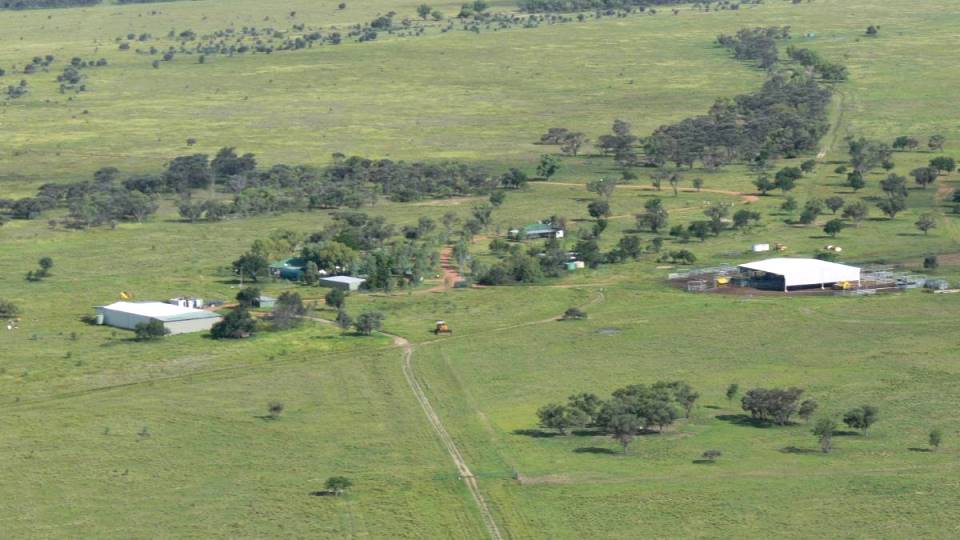
Agents have been overrun with inquiries for Caledonia, a 30,100ha grassed grazing property 110km from Aramac in central western QLD.
Meanwhile the dual-purpose breeding and fattening property Suvla, 70km south west of Winton, is enjoying a good season after receiving almost its long-term district average rainfall in February.
The 18,427ha holding comprises 50pc open downs with valley and channel country lightly grassed with summer herbages, button, Flinders and Mitchell grasses, and buffel along the creeks.
Twenty five percent is tableland plateau country, with the remainder lancewood and bendee ranges and broken gidgee foothill country.
It is jointly owned by Margaret Britton and her daughter Sandra Smith, who have decided to dissolve their partnership.
Tom Brodie from Brodie Agencies said there has been a good strike of fresh young Mitchell grass seedlings since last month’s rain.
“While the feed is good, the country will need another 30 to 50mm within the next two to three weeks to make it an excellent season,” he said.
Suvla is well watered with 15 dams that were recently filled and three sub-bores.
It is estimated to carry 800 breeders or 1200 weaners in an average season.
Suvla will be auctioned on April 11 and vendors will give early access for livestock for two paddocks once an unconditional sale contract is signed.
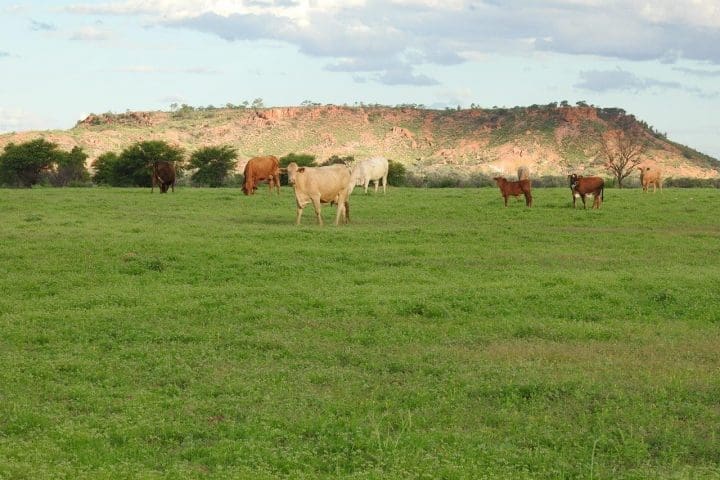
Suvla, southwest of Winton, will be auctioned on April 11 and vendors will give early access for livestock for two paddocks once an unconditional sale contract is signed.
Further east, three neighbouring properties at Theodore in Central Queensland will be auctioned separately next month by Hourn and Bishop Qld.
Bungaree is a 717ha block 12 km from Theodore and 2km from the Dawson River in Ve. It has mixture of soil types ranging from alluvial creek flats along Boam Creek to deep self-mulching brigalow clays and red brown softwood soils on the rises. Irrigated paddocks are designed to minimise runoff and take advantage of these different soil types for different crops.
The property features 214ha of flood irrigation, a 56ha centre pivot, 184ha of dryland cultivation (partial leuceana established) and 178ha of cattle grazing. The balance is water storage facilities including two dams, a tank and a pond.
With access to plenty of water, good soil and development potential, selling agent Gary Bishop said Bungaree was attracting solid interest from local irrigators.
In the meantime, cattle producers seeking expansion will be attracted to the two smaller blocks – 140ha Boam Downs South and 165ha Gralows.
More than half of Boam Downs South has established leucaena, with the balance good quality Theodore scrub country covered with buffel and native grasses. Water is available from the Dawson River via an easement and there is one dam.
The contoured ex-cultivation country on Gralows is planted to Cunningham leuceana, with the balance natural grass country. It has duplex soil types, with forest country and some better-quality flats and is watered by a bore.
Mr Bishop said interest had been strong because there’s not much on the market.
“Grass country in the Theodore/Moura/Dawson Valley is making between $2500 and $3700/ha depending on the quality. Stronger prices are being paid for Leucaena country – between $3700 and $5000/ha.”
Mr Bishop said the properties are likely to attract two different buyer types.
“The original intention was to sell Bungaree to an irrigator and the other two paddocks to local producers for add-ons. However, with the current seasonal conditions, there is every chance that someone might come along and buy all three because of the water security.”
Bungaree (Lot 1) and Gralows (Lot 3) are owned by Rohan and Suzanna Hindle who are selling to pursue other business interests. Brian and Susan Wagner own Boam Downs South (Lot 2) and are downsizing to concentrate on irrigation.
The Theodore Aggregation will be auctioned on April 16.
Aviation history behind New South Wales grazing operation
An historic Mudgee district grazing property once owned Australian entrepreneur and businessman, Dick Smith, has been listed for sale for the second time in three years.
Wing Vee is a 3865ha operation, 66km west Mudgee, on the NSW Central Tablelands. It once formed part of Triamble Station, settled by the Suttor family of Brucedale (one of Australia’s oldest and finest homes) at Bathurst, more than 200 years ago.
During World War II, the property’s two airstrips were used by the Air Force to train fighter pilots and it became known as Wing Vee.
Mostly basalt, the country ranges from sheltered valleys to open grazing slopes and timbered ranges. Despite the dry conditions, it carries a big body of natural pasture interspersed with clovers.
Wing Vee receives 650mm annual rainfall and boasts 14km of Macquarie River/Burrendong Dam frontage.
Recent infrastructure upgrades include a new water system (with troughs and tanks, dams cleaned and renewed), four new sets of cattle, sheep and goat yards, a new machinery shed and 22km of new fencing.
In 2016, it was purchased by father and son, Ross and Eric Sharwood to complement their Dubbo and St George grazing properties, however the pair has now decided to consolidate.
Chris Korff and Mark Schwerin from Ray White Rural, who are handling the sale, report most of the interest is from sheep producers in South Australia, Queensland, western NSW, as well as locals.
“Wing Vee is currently destocked, but it can carry 14,000 DSE. Previous owners have run cattle. When Dick Smith owned it back in the 1990s, he was running a mixed enterprise – around 700 cows and 5000 sheep,” they said.
Mudgee district properties have been selling upwards of $1800/ha and the agents are hoping Wing Vee will achieve local expectations.
The property will be auctioned by Ray White Rural on March 29.
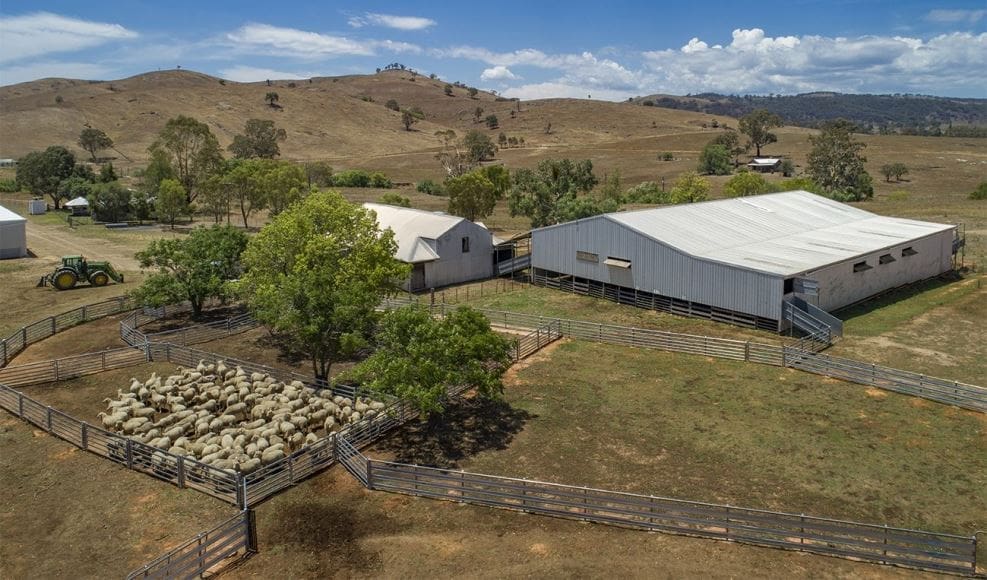
Wing Vee, an historic Mudgee district grazing property once owned Australian entrepreneur and businessman, Dick Smith, has been listed for sale for the second time in three years.
Drought bites three NSW Upper Hunter listings
MacCallum Inglis is negotiating with an interested party for the Upper Hunter Valley property Mandalea which has been relisted with a reduced tag of $7 million after failing to sell via an expressions of interest campaign.
Situated east of Scone, Mandalea was originally part of the historic Belltrees Station.
In 1948, the original 728ha of country was granted to Ian MacCallum as a soldier settlers’ block but Mandalea grew to with the addition of adjoining properties Ardroy and Oakendale in 2002 and 2011 respectively.
Today the property spans 2843ha and is owned by Ian’s son Ken and his wife Doon who have semi-retired and moved closer to Scone.
Selling agent Michael Burke said despite the tough seasonal conditions, inquiry has been strong.
“It is coming from New South Wales and Queensland – from private buyers and some funds. We are looking at a balance of beef cattle and mixed grazing operators.”
Mr Burke said Mandalea’s diversity had been its strength.
“The property features 485ha of arable land and boasts diverse improvements to suit both sheep and cattle production. As a result, award winning fine wool fleeces have been grown and prime market topping bullocks have been fattened on Mandalea.”
The property is watered by a balance of natural and pumped water via bores and the Hunter River.
The property, which has been destocked for 18 months, is being offered bare of stock, but at its peak can carry 700 cows and calves plus 1200 sheep and 40 horses.
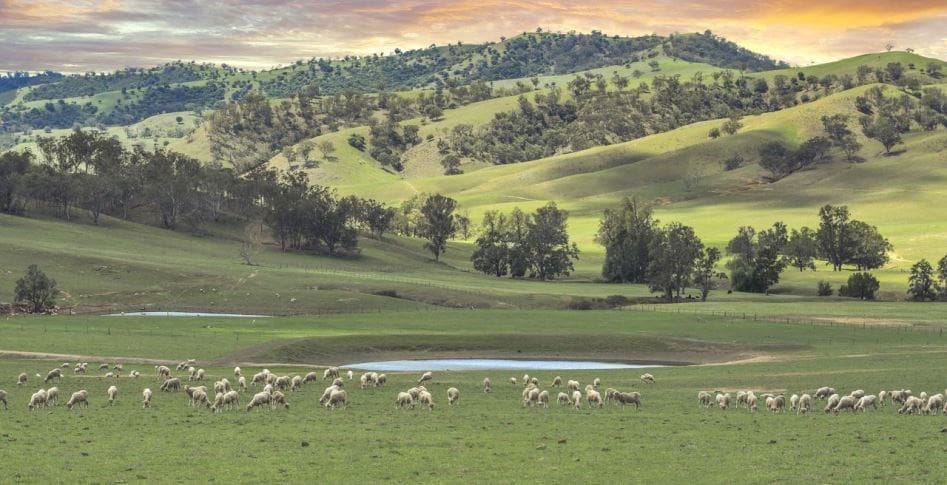
The Upper Hunter Valley property Mandalea is expected to make between $7.5m and $8m when expressions of interest close on December 6.
In the meantime, Mr Burke is marketing separately the 1463ha frontage country off Mandalea.
Listed for $4 million, Ardroy /Oakendale is located 35 minutes east of Scone and runs alongside the historic Belltrees Station.
In a normal season, it is ideal breeding and fattening country and, in the past, has turned off 700kg plus bullocks.
Ardroy /Oakendale features a balance of land types, ranging from long stretches of creek flats, to arable slopes running into hills and steeper country. Predominantly, it is red basalt/loam with some heavier soils in sheltered valleys.
Water is by way of two bores, tanks, troughs and 22 dams, with frontage to the now dry Stoney and Donalds Creeks.
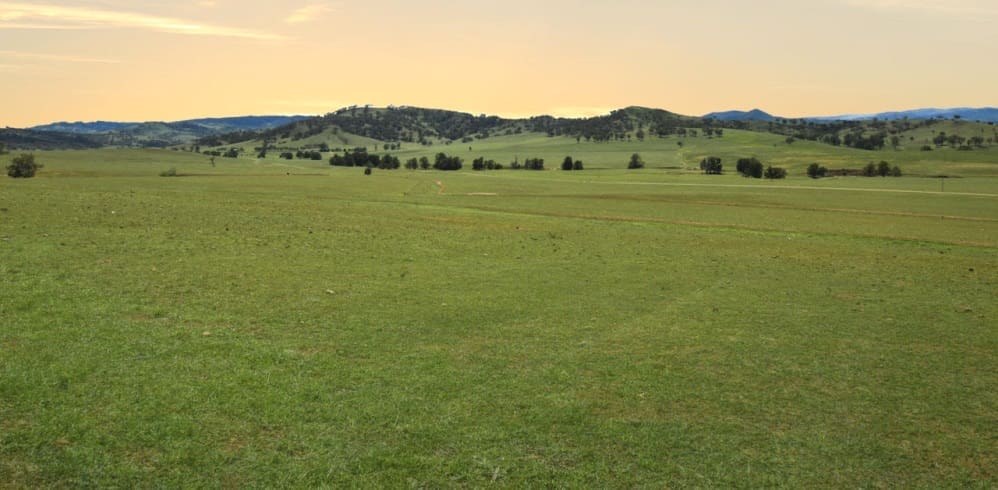
Despite the tough seasonal conditions, inquiry for Ardroy and Oakendale has been strong.
Offers over $6 million are being sought for the Scone district property Camyr-Allyn, also in the highly-regarded Upper Hunter Valley.
Featuring 100 percent arable alluvial flats and moderate slopes and some of the district’s most reliable irrigation water, the 197ha block is suited to irrigation, beef cattle or horses.
It is running 100 cows and calves and currently produces lucerne hay for the thoroughbred industry – around 50,000 bales this cutting season.
Mr Burke said despite experiencing one of the toughest seasons on record, Camyr-Allyn is performing well.
“The irrigation water on the property has not dropped to date which means it continues to irrigate. As a result, this season’s yield is expected to be the biggest yet.”
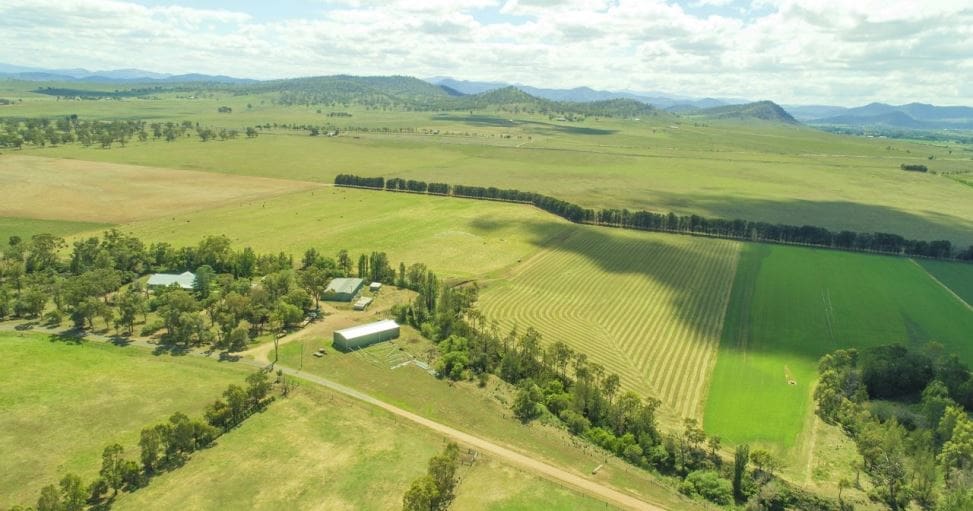
Camyr-Allyn features 100pc arable alluvial flats, moderate slopes and some of the Scone district’s most reliable irrigation water.
Click here to access more properties listed for sale

The Proserpine Farm would be perfect for housing development especially the land close to Proserpine town.